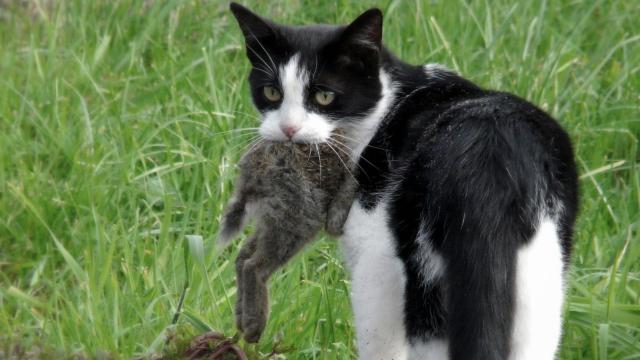If you’re like me, your brain is so riddled with cat virus that you never want to hear anything negative about our whiskered overlords. But sometimes, the truth is so dark it simply begs to be thrust into the light. This is one of those times.
Image: Wikimedia
Cats are an ecological disaster — they’re shaping up to be one of the biggest contributors to the sixth mass extinction. A global analysis published this week in the Proceedings of the National Academies of Sciences finds that feral cats have helped drive at least 63 species of birds, mammals and reptiles into the dirt over the past 500 years. The only group of invasive predators that’s done more harm is rodents, which are linked to 75 species extinctions.
Dog lovers have no right to be smug, either: Woof-woof is also making a killing out there, contributing to nearly a dozen extinctions as an invasive predator.
The fact that our furry lap companions are wreaking ecological havoc isn’t exactly news to biologists. For years, scientists have been methodically documenting the impact of introduced predators around the world, from rats killing rare native birds in New Zealand, to feral cats and introduced foxes decimating Australia’s digging mammals. But until now, no single study could tell us just how bad the problem was on a global scale.
“We identified a need for a worldwide assessment across all regions and predator species,” Tim Doherty of Deakin University in Australia told Gizmodo. “This information allows us to determine how invasive predator impacts vary across predators, prey species and geographic locations.”
Pulling data from the International Union for Conservation of Nature’s Red List and other sources, Doherty and his colleagues have now confirmed that invasive predators — primarily rodents and cats, but also dogs, pigs, red foxes and the small Indian mongoose — are a leading cause of declining biodiversity worldwide. All told, invasive predators have contributed to at least 87 bird, 45 mammal and 10 reptile extinctions, which amounts to more than half of all known extinctions in these groups. Another 596 species are now threatened by introduced carnivores.
“The large number of extinctions invasive predators have contributed to was shocking,” Doherty said.
Not surprisingly, the vast majority of species that have fallen victim to invasive predators are what ecologists call “insular endemics”: Animals that are geographically isolated and in many cases occupy a narrow ecological niche. Countries like New Zealand and Madagascar, both renowned for their endemic biodiversity, are among the hardest-hit.
Clearly, these places ought to be taking the problem seriously. This winter, New Zealand announced its intention to eradicate all introduced predators by 2050, including rats, possums, stoats, ferrets and feral cats. But how exactly the island nation plans on achieving that remains to be seen.
In all likelihood, eradicating invasive predators is going to take a mix of tried-and-true methods like lethal trapping and predator fences, and newer, more speculative technologies like gene drive. By shedding light on just how many species are at stake, Doherty hopes his study will spur new investment in this area.
Of course, you also have an important part to play, by keeping your beloved critters indoors. If you must let them out, at least make sure they’re fixed.
[PNAS]
